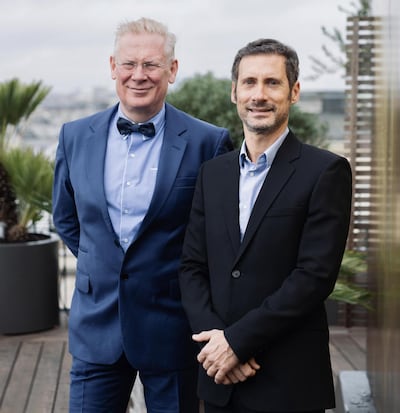Legacy beauty brands generally take decades to reach a level of market dominance which sees them leak out into the popular consciousness.
Several have achieved this; brands with names that will be recognisable even to people whose engagement with the beauty industry is limited to toothpaste, soap and anti-dandruff shampoo.
You’ll know them – those like the brand which has become synonymous with luxury skincare, La Mer. While the beauty industry may have a fluffy exterior, it is a particularly lucrative, yet saturated and intensely competitive, market.
New companies attempting to eke out a niche and reputation must face off against behemoths with marketing budgets to match their status, and most new brands fail within their first year.
The results were amazing. A skin graft was avoided. Scarring was avoided
The global skincare market alone was valued at over $145 billion in 2020. Though it has certainly thrived and penetrated popular awareness as a symbol of haute skincare, luxury brand Augustinus Bader – with its now globally recognisable royal blue bottles – only launched in 2018.
While existing brands offer ranges featuring hundreds of products designed to be used synchronously in complex regimes, the new name in premium skincare launched with just two products – the cream, for oily and balanced skin, and the rich cream for dry skin. Three years ago, at the height of Korean-inspired multi-layered skincare routines, this was a single product declaring itself all anyone needed.
In an interview, Gwyneth Paltrow declared that she uses the rich cream at night, and countless celebrity endorsements followed. The brand became the talk of beauty editors all over the world, winning countless awards.
Among others, actresses Courtney Cox and Melanie Griffiths invested in the company. Since that launch, Augustinus Bader has grown at an almost unprecedented rate, rising above legacy competitors to become one of the most recognisable names in luxury skincare within three years. Sales of £7 million in 2018 rocketed to £70 million last year and continue to grow.
Bader himself is director and professor of Applied Stem Cell Biology and Cell Technology at the University of Leipzig. He has the sort of mellow, gentlemanly manner and proclivity for bow ties that feels of another time but is especially novel in contrast to the extroversion of the beauty industry. He almost seems as though he's lost his way en route to a medical conference and just happened to create one of the most renowned beauty products on earth.

One of the leading global experts in stem cells, the 62-year-old German professor created a wound gel designed for use on burns victims. It rehabilitates the skin with minimal scarring and without the need for skin grafts. Creating a premium skin cream that sells in Brown Thomas for just under €200 a bottle wasn’t his intended career path, and it remains secondary to his research, which he is always enthusiastic in discussing.
When I mention the success of the brand that bears his name, Bader exhibits a demure, almost shy, delight. He says that in the early days of his research, his alternative to organ transplantation and skin grafting was largely rejected.
“My controversial idea was a little bit early perhaps, but now with the skincare, though it is not a form of medical treatment, they share a common idea – that you can trigger or help your own repair.” Ten per cent of the brand’s net sales went to wound-healing research and other charities in 2020.
Bader met French financier Charles Rosier at a dinner in Leipzig and showed Rosier images of the effect of his wound gel on a four-year-old girl who had suffered second- and third-degree burns. "I was stunned by the pictures", Rosier says.
Rosier says that customer feedback is so enthusiastic and forthcoming that the brand is creating products based on demand
“The results were amazing. A skin graft was avoided. Scarring was avoided. I was thinking ‘How can there be such a discovery in existence and it’s not widely available?’ It would change the lives of so many people. It would have a major positive impact.” Rosier’s answer to his own question is not uplifting – “most victims of burns come from developing countries, because that’s where fire is being used to cook and to heat homes”.
Financing clinical trials costs tens of millions and as a result, Rosier suggests that investing that sort of money in Bader’s wound gel would constitute “a risky financing with maybe not so much return for pharmaceutical groups”. When they met that evening, Bader had not secured the funding he needed.
Without experience in the beauty industry, but with a finance background, Rosier says he and Bader brainstormed on how they could leverage the professor’s discoveries to “find a pragmatic way to finance his research”.
Rosier puts the pair’s initial enthusiasm down to naivety. He believed that the professor’s scientific credentials were unmatched. He considered that Bader’s TFC8 complex was unique enough to establish a niche in the beauty industry and carry a brand to major success. The professor describes TFC8 as a combination of certain “vitamins, lipids, nutrients and amino acids which are precursors for our intact skin cells in our intact skin” that are necessary for the skin to repair itself.
Despite the brand’s original one product ethos, it launched numerous products in the face and body category last year and is about to launch Augustinus Bader The Serum (€320) and Augustinus Bader The Eye Cream (€185). Bader himself confirms that “our philosophy remains that all the products are standalone products. There are various formulations because people have different skin needs – the rich cream, for example, may be better if you live in a dry climate or maybe have drier skin.”
He is not suggesting that people need to buy all the products and use them simultaneously. They all contain his TFC8 complex. Rosier says that customer feedback is so enthusiastic and forthcoming that the brand is creating products based on demand.
“If you look at peers to Augustinus Bader in the premium skincare world, on average they offer ranges of a 150 to 200 products. We won’t do that. It isn’t our DNA. We still maintain that philosophy of simplicity, and the product range is a very curated assortment compared to our peers.”
So far, the brand has risen to prominence by doing things differently. It will be interesting to see if it continues to win out with that strategy.




















